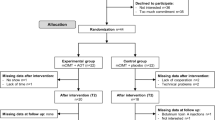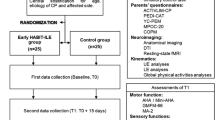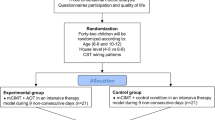Abstract
Motor function difficulties associated with unilateral spastic cerebral palsy (USCP) impact gait inter-limb coordination between the upper and lower extremities. Two motor learning based, upper extremity treatments, Constraint Induced Movement Therapy (CIMT) and Hand Arm Bimanual Therapy (HABIT), have resulted in improvements in coordination and function between the arms in children with USCP. However, no study has investigated whether coordination between the upper and lower extremities improves after either intervention during a functional task, such as walking. Gait analysis was performed before and after participation in intensive (3 weeks, 90 h total) CIMT and HABIT interventions to determine if intensive upper extremity treatment can improve inter-limb coordination between the upper and lower extremities of children (n = 20, 6–17 years old) with USCP. While upper extremity clinical evaluations indicated hand function improvements, there were no changes in lower extremity parameters for either treatment. However, we found that 10 out of 11 children with a 2:1 arm swing-to-stride ratio at pre-test improved to a 1:1 ratio at post-test. Temporal synchronicity of contralateral limbs, swing displacement of the more affected arm, and arm swing side symmetry unexpectedly decreased. Positive changes in coordination were observed in children who demonstrated poor coordination during walking at pre-test, yet the changes were not robust. Principle component analysis did not indicate changes in limb coupling. While more coordinated, gross-motor training of the upper and lower extremity may reveal greater changes, lower extremity gait patterns were not improved in high functioning children with USCP.


Similar content being viewed by others
References
Abdi H, Williams LJ (2010) Principal component analysis. Wiley Interdiscip Rev Comput Stat 2(4):433–459
Bax M, Goldstein M, Rosenbaum P, Leviton A, Paneth N (2005) Proposed definition and classification of cerebral palsy, April 2005. Dev Med Child Neurol 47:571–576
Bell K, Ounpuu S, DeLuca P, Romness M (2002) Natural progression of gait in children with cerebral palsy. J Pediatr Orthop 22:677–682
Bleyenheuft C, Detrembleur C (2012) Kinematic covariation in pediatric, adult and elderly subjects: Is gait control influenced by age? Clin Biomech 27(6):568–572
Bleyenheuft C, Deltombe T, Detrembleur C (2013) Influence of ankle-foot orthoses on kinematic segmental covariation among stroke patients. Ann Phys Rehabil Med 56(1):3–13
Bleyenheuft Y, Ebner-Karestinos D, Surana B, Paradis J, Sidiropoulos A, Renders A et al (2017) Intensive upper- and lower-extremity training for children with bilateral cerebral palsy: A quasi-randomized trial. Dev Med Child Neurol 59(6):625–633
Bohm H, Doderlein L (2012) Gait asymmetries in children with cerebral palsy: Do they deteriorate with running? Gait Posture 35:322–327
Bruijin S, Meyns P, Jonkers I, Kaat D, Duysens J (2011) Control of angular momentum during walking in children with cerebral palsy. Res Dev Disabil 32:2860–2866
Cappellini G, Sylos-Labini F, MacLellan MJ, Sacco A, Morelli D, Lacquaniti F, Ivanenko Y (2018) Backward walking highlights gait asymmetries in children with cerebral palsy. J Neurophysiol 119(3):1153–1165
Charles J, Gordon A (2006) Development of hand-arm bimanual intensive training (HABIT) for improving bimanual coordination in children with hemiplegic cerebral palsy. Dev Med Child Neurol 11:931–936
Coker P, Karakostas T, Dodds C, Hsiang S (2010) Gait characteristics of children with hemiplegic cerebral palsy before and after modified constraint-induced movement therapy. Disabil Rehabil 32(5):402–408
Delabastita T, Desloovere K, Meyns P (2016) Restricted arm swing affects gait stability and increased walking speed alters trunk movements in children with cerebral palsy. Front Human Neurosci 10(354):1–16
Donker S, Beek P, Wagenaar R, Mulder T (2001) Coordination between arm and leg movements during locomotion. J Mot Behav 33:86–102
Ferris D, Huang H, Kao P (2006) Moving the arms to activate the legs. Exerc Sport Sci Rev 34(3):113–120
Gordon A, Charles J, Wolf S (2005) Methods of constraint-induced movement therapy for children with hemiplegic cerebral palsy: development of a child-friendly intervention for improving upper-extremity function. Arch Phys Med Rehabil 86:837–844
Gordon A, Hung Y, Brandao M, Ferre C, Kuo H, Friel K et al (2011) Bimanual training and constraint-induced movement therapy in children with hemiplegic cerebral palsy: a randomized trial. Neurorehabilit Neural Repair 25(8):692–702
Hsu A, Tang P, Jan M (2003) Analysis of impairments influencing gait velocity and asymmetry of hemiplegic patients after mild to moderate stroke. Arch Phys Med Rehabil 84:1185–1193
Kim CJ, Son SM (2014) Comparison of spatiotemporal gait parameters between children with normal development and children with diplegic cerebral palsy. J Phys Therapy Sci 26(9):1317–1319
Leys C, Ley C, Klein O, Bernard P, Licata L (2013) Detecting outliers: Do not use standard deviation around the mean, use absolute deviation around the median. J Exp Soc Psychol 49(4):764–766
Lythgo N, Wilson C, Galea M (2011) Basic gait and symmetry measures for primary school-aged children and young adults. II: Walking at slow, free and fast speed. Gait Posture 33(1):29–35
Menkveld S, Knipstein E, Quinn J (1988) Analysis of gait patterns in normal school-aged children. J Pediatr Orthop 8:263–267
Meyns P, van Gestel L, Massaad F, Desloovere K, Molanaers G, Duysens J (2011) Arm swing during walking at different speeds in children with cerebral palsy and typically developing children. Res Dev Disabil 32:1957–1964
Meyns P, Desloovere K, Van Gestel L, Massaad F, Smits-Engelsman B, Duysens J (2012a) Altered arm posture in children with cerebral palsy is related to instability during walking. Eur J Paediatr Neurol 16:528–535
Meyns P, van Gestel L, Bruijn S, Desloovere K, Swinnen S, Duysens J (2012b) Is interlimb coordination during walking preserved in children with cerebral palsy? Res Dev Disabil 33:1418–1428
Meyns P, Molenaers G, Desloovere K, Duysens J (2014) Interlimb coordination during forward walking is largely preserved in backward walking in children with cerebral palsy. Clin Neurophysiol 125(3):552–561
Novak I, McIntyre S, Morgan C, Campbell L, Dark L, Morton N, Stumbles E, Goldsmith S et al. (2013) A systematic review of interventions for children with cerebral palsy: State of the evidence. Dev Med Child Neurol 55:885–910
Ortega J, Fehlman L, Farley C (2008) Effects of aging and arm swing on the metabolic cost of stability in human walking. J Biomech 41:3303–3308
Park J (2008) Synthesis of natural arm swing motion in human bipedal walking. J Biomech 41:1417–1426
Sutherland D, Olshen R, Cooper L, Woo S (1980) The development of mature gait. J Bone Jt Surg 62:336–353
Wheelwright E, Minns R, Law H, Elton R (1993) Temporal and spatial parameters of gait in children. I: Normal control data. Dev Med Child Neurol 35:102–113
Zipp G, Winning S (2012) Effects of constraint-induced movement therapy on gait, balance, and functional locomotor mobility. Pediatr Phys Therapy 24:64–68
Acknowledgements
The authors would like to acknowledge Dr. Victor Santamaria for his statistical advisement, Dr. Lily Hung for her assistance with data collection, and the children and families for their participation in the interventions.
Author information
Authors and Affiliations
Corresponding author
Ethics declarations
Conflict of interest
The authors declare that they have no conflict of interest.
Ethical approval
All procedures performed in studies involving human participants were in accordance with the ethical standards of the institutional and/or national research committee and with the 1964 Helsinki Declaration and its later amendments or comparable ethical standards.
Additional information
Publisher’s Note
Springer Nature remains neutral with regard to jurisdictional claims in published maps and institutional affiliations.
Rights and permissions
About this article
Cite this article
Sidiropoulos, A.N., Chen, S., Kaminski, T.R.M. et al. Modulation of gait inter-limb coordination in children with unilateral spastic cerebral palsy after intensive upper extremity intervention. Exp Brain Res 237, 1409–1419 (2019). https://doi.org/10.1007/s00221-019-05501-6
Received:
Accepted:
Published:
Issue Date:
DOI: https://doi.org/10.1007/s00221-019-05501-6




